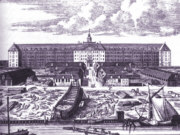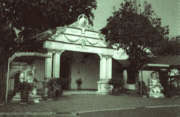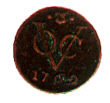How white racistic colonialism has stormed around in
Indonesia. Chronology
Indonesia chronology 1670 to 1799: Court Intrigues and Dutch colonialism

Warehouse of criminal racist VOC in Holland
from: Charles A. Gimon: http://www.gimonca.com/sejarah/sejarah.shtml
presented by Michael Palomino (2005 / 2016)
| Share: |
Facebook |
|
Twitter
|
Summary: 1670-1800: VOC meddles with the inner wars between the Island kingdoms and wants - despite of all rebellions - to take advantage for herself. Also exiling the Sultans to Ceylon or even to South Africa is not seldom. VOC achieves almost to monopolize some spices at all for about 100 years. Add to this coffee and tea is cultivated. From 1740 on VOC and some Sultans are agitating against Chinese with the consequence of mass murder on Chinese people. At the end VOC is breaking down by corruption and intrigues.
Michael Palomino, May 2005.
1670
VOC establishes outposts at Bengkalis (across the straits from Melaka) and Perak, both for controlling the trade in tin.
Balambangan in easternmost Java becomes independent of Balinese rule.Trunojoyo unites Madura under his control, drives out Mataram forces.
1671
(Note: throughout this page, VOC stands for Vereenigde Oostindische Compagnie, or the Dutch East India Company. The VOC had been granted many of the powers of a sovereign state by the government of the Netherlands.)Gunung Merapi erupts in Mataram.
1672
VOC recognizes Arung Palakka as King of Bone.
In 1672, Louis XIV of France invaded the Netherlands with 100,000 soldiers. The Dutch had to open the dikes and flood the fields to prevent Amsterdam from falling to the French. However, since travel and communication were so slow in the 1600s and 1700s, these events had little effect on the activities of the VOC, which had the power to govern itself in any case.Famine in Mataram.
1674
Bugis under Arung Palakka attack Toraja.
Makassarese unhappy with Arung Palakka settle in East Java.Rebellion in Mataram, with help from Trunojoyo.
1675
Makassarese exiles attack ports on north coast of Java.
Trunojoyo of Madura takes Surabaya. Rebels appeal to Islamic sentiments among the common people against both the court of Mataram and the VOC.Trunojoyo defeats Mataram army at Gogodog.
1676
Amangkurat I sends his son, Pangeran Puger, to the VOC to ask for help.
VOC sends Admiral Speelman to fight the rebels against Mataram in North Java and Madura. Speelman quiets the rebellion along the coast between Cirebon and Jepara.February 25 VOC makes a treaty with Amangkurat I:
1677
-- VOC will help Mataram
-- VOC territory around Batavia will be extended eastward
-- VOC may establish a factory anywhere they like without any restrictions on exports or imports
-- Mataram will restrict Malays, Arabs and other outsiders from settling in Mataram
-- Mataram will repay the VOC for the cost of putting down the rebellion
-- Speelman receives the right to make treaties on behalf of Amangkurat I.
May VOC pushes Trunojoyo out of Surabaya. Trunojoyo leaves behind over 100 cannon.
May Trunojoyo moves on to loot the court of Mataram at Plered. Both loyal and rebellious members of the family of Amangkurat I flee. Trunojoyo takes the royal treasury and retreats to Kediri.
Banten forces occupy Cirebon and the Priangan.
July Amangkurat I dies. Amangkurat II seeks VOC help against the rebels.
Balinese from Karangasem drive Makassarese off of Lombok.
VOC occupies Sangir islands.
1678
January 15 Amangkurat II gives the VOC a monopoly on the sugar trade in Jepara.
Amangkurat II, without money to pay his debts to the VOC, promises to give up Semarang, his claims to the Priangan, and fees from coastal ports until debts are paid.
VOC and Amangkurat II march on Kediri and destroy Trunojoyo's headquarters after a fifty-day siege. Arung Palakka and his supporters fight for the VOC as mercenaries, and conspire to win away Makassarese mercenaries fighting for Trunojoyo. Captured gold and treasure is distributed among the victorious troops.
Amangkurat II receives back the gold crown of Majapahit, an heirloom of the house of Mataram, but its central diamond is missing (possibly stolen by a Dutch soldier). Trunojoyo himself escapes.
Inayatullah becomes Sultan of Banjar on Kalimantan.
December 9 Nine Makassarese chiefs who had been fighting for Trunojoyo as mercenaries surrender to the VOC, and are allowed to return to Sulawesi.
Throughout this period, the rulers of Mataram borrowed money from the VOC, which turned out to be a bad deal for both. The rulers of Mataram lost power and sovereignty, but the debts to the VOC were never fully repaid, and the VOC lost money year after year.VOC and Arung Palakka drive the remaining Makassarese out of East Java.
1679
Banten retreats from Cirebon and the Priangan.
VOC makes an alliance with Minahasans at Manado.
December 25 Trunojoyo gives himself up to the combined VOC and Mataram forces, under the promise that his life will be spared. He is executed anyway. (In one story, he is promised the post of minister and executed by Amangkurat II himself, with a royal keris)VOC forces attack rebel areas in Mataram.
1680
Pangeran Puger continues to run a court at Plered against Amangkurat II. Amangkurat II founds a new court at Kartasura (guarded by VOC troops), then drives Puger out of Plered.
Banten declares war on VOC. Sultan Ageng is replaced in coup by his son, Sultan Haji, who seeks help from the VOC.
VOC forces invade Madura, supposedly on behalf of Mataram. Cakraningrat II, uncle of Trunojoyo, takes power in West Madura. VOC retains control of East Madura.January 6 VOC signs agreement with the princes of Cirebon
1681
-- for mutual assistance in case of emergencies
-- and agreeing on severe punishment if any of the three heads rebelled against the VOC
-- Cirebon will not build any fortifications without VOC approval
-- the VOC has a monopoly on pepper in Cirebon
-- and the princes may control the export of sugar and rice from Cirebon.
Pangeran Puger builds a new force and retakes the center of Mataram, but not Kartasura. VOC forces push him back and defeat him.
VOC intervenes in Roti, puts allies in power.
Karangasem begins trying to take Lombok.Sultan Ageng's supporters, including much of the population, retake Banten against his son. VOC reacts by taking Banten with superior firepower. VOC expels English and other European traders from Banten, and begins to control
1682
-- Cirebon
-- the Priangan
-- and Lampung.
Syekh Waliyullah, Islamic scholar and enemy of the Dutch, is exiled to the VOC post in Ceylon.April 17 VOC renews its 1659 treaty with Banten; in addition,
1684
-- Banten gives up its claims to Cirebon
-- and grants the VOC a monopoly in the pepper trade in Lampung.
April 28 VOC cancels the debts owed by the Sultan of Banten, but only on the condition that the previous treaties between the VOC and Banten are obeyed.
Surapati, (also called Untung), a former slave and outlaw, now employed as a VOC soldier, attacks a VOC column and escapes. He travels across the countryside of Java gathering followers.
Surapati instructs his followers to kill two officials in Banyumas who were rebelling against the authority of Mataram. He receives the gratitude of Amangkurat II, and is given refuge by anti-VOC members of the court of Mataram at Kartasura.Post is founded at Bengkulu by English traders who had been forced to leave Banten.
1685
VOC forces treaty on Sultan of Riau.
Sa'dillah becomes Sultan of Banjar.February 15 VOC receives a complete monopoly on pepper in Banten.
1686
VOC sends an embassy to the Mataram court at Kartasura, demanding the return of Surapati. Amangkurat II stages a fake attack on Surapati's residence, then has his soldiers turn to cut down VOC representatives and soldiers, with the help of Pangeran Puger. The remaining VOC presence at court leaves for Jepara.
Amangkurat II sends an ambassador to the VOC at Jepara claiming that he took no part in attacking the Dutch.
Surapati and the chief minister of Amangkurat II leave Kartasura for Pasuruan. Amangkurat II orders his ministers in Madura and Surabaya to make the appearance of pursuit.
Surapati begins building a new kingdom for himself in easternmost Java.
Amangkurat II sends secret letters to Johore, Minangkabau, English East India Co, even Siam trying to find help against VOC.Local leader on Bangka (claimed by Palembang) asks for VOC protection. 1689 Plot against VOC in Batavia fails; rebels flee to Kartasura. 1690 Amangkurat II stages another mock attack on Surapati at Pasuruan. The promised VOC help arrives late, foiling the plans to ambush the VOC soldiers again.
1688
VOC abandons outpost at Perak.
Tea is introduced on Java.VOC begins contacts with Bataks around Lake Toba, Sumatra.
1694Sultanate of Asahan is founded on Sumatra, as a dependency of Siak.
1695Arung Palakka, King of Bone, passes away.
1696
Sultan Muhammad Syah of Indrapura abdicates. VOC gains influence in the absence of a ruler there.King of Buleleng in Bali takes Balambangan on Java and returns it to Balinese rule.
1697Surapati takes areas around Madiun.
1699
VOC introduces coffee cultivation to Java.
VOC increases influence around Kutai on Kalimantan.
Sultan Mahmud II of Riau is assassinated; civil war breaks out.
Earthquake at Batavia.
1700
Tahlilillah becomes Sultan of Banjar.Three years of confusion in the VOC ensue over the post of Governor-General.
1701
Sultan of Banjar tries to eject the British post there by force, but fails.Amangkurat II sends a secret representative to the VOC, hoping for help in the face of court intrigues.
1702
Antonio Coelho Guerreiro arrives as the first official governor of Portuguese Timor.
During the 1700s, the Portuguese on Timor were limited to outposts along the northern coast only.Amangkurat II dies. Amangkurat III faces opposition from Pangeran Puger.
1703
Amangkurat III tries to take the wife of Cakraningrat II of Madura, who complains to her husband. Cakraningrat II in turn urges Pangeran Puger to take the crown of Mataram away from Amangkurat III.Puger leaves the court of Mataram at Kartasura for Semarang, seeking VOC help. Puger gets support from Cakraningrat II of Madura. Amangkurat III demands that the VOC return Puger to his custody; the VOC refuses.
1704
Amangkurat III takes the son of Pangeran Puger (Raden Surya Kusuma) into custody intending to execute him.
Gunung Merapi begins erupting in the midst of this plan; Amangkurat III interprets this as a sign, and elevates the son to the level of Pangeran himself.
VOC army takes Demak and other coastal areas on behalf of Pangeran Puger.
1705
VOC warehouse and docks in the Netherlands, from an old engraving. Amangkurat III sends an ambassador to the VOC at Semarang, but too late: the VOC has already received Pangeran Puger favorably. Representatives of both rivals are sent to Batavia at the same time.
Warehouse of criminal racist VOC in Holland
March 18 VOC recognizes Pangeran Puger as Susuhunan Pakubuwono I.
VOC sends reinforcements to Semarang.
June 19 Susuhunan Pakubuwono I takes his office in a public ceremony at Semarang.
Surapati offers to make a conditional surrender to the VOC; the VOC rejects his offer.
Army of Pakubuwono I with VOC help takes the court of Mataram at Kartasura.
(The VOC bribes the commander of the troops at Kartasura, allowing them to take Salatiga and other approaches without significant resistance).
Raden Surya Kusuma is strangled; other officials who remain are allowed to keep their posts. Amangkurat III flees to Surapati with the pusaka (emblems or heirlooms of the house of Mataram) and moveable assets in gold and jewels. Four years of warfare begin.
October 5 Pakubuwono I makes a deal with the VOC:
-- Mataram debts to VOC are wiped out
-- East Madura goes to VOC control
-- Semarang is officially a VOC city after years of occupation
-- Cirebon is officially a VOC protectorate
-- VOC gets extensive trade rights
-- Javanese sailors must stick to their home waters
-- Mataram must deliver rice on demand to the VOC at a price set by the VOC.
In addition, the two sides agree that no other European nation will be allowed to build factories or fortifications anywhere on Java.
October 11 Pakubuwono I signs an agreement to pay the costs of the VOC garrison at Kartasura.VOC and Mataram armies take Kediri, and defeat Amangkurat III and Surapati. Surapati escapes with serious wounds, and dies in the mountains. Surapati's son Pangating convinces local leaders around Gresik, Kediri and Balambangan to continue supporting Amangkurat III. The war on Java continues.
1706
Muhammad Mansur Jayo Ing Lago becomes Sultan of Palembang.VOC and Pakubuwono I of Mataram battle the forces of Amangkurat III at Madiun, and take Pasuruan. Amangkurat III flees to Malang, where he is attacked by the Pangeran of Blitar.
1707
Cakraningrat III takes power in West Madura.
Banjar finally throws out the British.VOC forces land at Surabaya to continue fighting against Amangkurat III.
1708
July 17 Amangkurat III surrenders himself at Surabaya, after receiving a false VOC promise of lands and freedom in exchange for surrender.
August 24 Amangkurat III, his family and attendants are sent by ship from Surabaya to Batavia. At Batavia, he is told that the VOC representative at Surabaya had no authority to offer him terms of surrender. He is taken as a prisoner of war and sent to exile in Ceylon.
When Amangkurat III surrendered, he also surrendered the remaining heirlooms of the house of Mataram in his possession, but the gold crown of Majapahit disappeared at about that time, and was never seen again.Dewa Agung (high king) on Bali moves court from Gelgel to Klungkung.
1710
VOC opens tin mines on Bangka.
Around this time, many Bugis, who had been wandering as mercenaries or refugees due to the wars involving Makassar and Bone, began to settle on and around the Malay peninsula.Pakubuwono I sends repeated requests to the VOC in Batavia for help against continuing unrest in Balambangan and Madura.
1712British begin building Fort Marlborough at Bengkulu.
1714
Sultan of Tidore cedes claim on Irian Jaya to VOC.
Komaruddin becomes Sultan of Palembang.
After this time (especially after the Treaty of Utrecht in 1713, which ended 13 years of war between the European powers and their colonies) the Dutch and the VOC began to lose prominence, and Britain became the dominant colonial and naval power in the world.King of Mengwi becomes most powerful king on Bali.
1717
VOC accuses the Adipati of Surabaya of collaborating with the rebels in eastern Java. Pakubuwono I is unhappy about the conflict between his mutually loyal relationship with the Adipati and his relationship with the VOC. The aged Adipati offers his surrender in the hope of avoiding further unrest. He is executed at Kartasura.
The son of the Adipati of Surabaya, Jaya Puspita, leads a renewed rebellion against Mataram in the areas around Surabaya, Kediri, Probolinggo, Balambangan, and Madura, with help from Bali. The VOC organizes further reinforcements to counter the threat.
Rice shortages spread due to the increased civil disorder.VOC takes Surabaya and Madiun from the rebels. Some rebellions continue in east Java.
1718
Cakraningrat III of Madura is killed by VOC soldiers while travelling to talks; Cakraningrat IV takes power.Amangkurat IV takes rule in Mataram. Court rebellion breaks out almost immediately; rebel princes flee eastward. A combined VOC and Mataram force drives the rebels back from Kediri to Malang.
1719Rumors of a conspiracy against the VOC spread in Batavia. Peter Erberfelt and several others are tried and executed.
17211722
Bugis take over Riau and the entire Sultanate of Johore. Johore remains under Bugis influence for many years.
VOC receives a monopoly on tin from Bangka and Belitung from the Sultan of Palembang.Rebel princes and Surapati's descendants in East Java are subdued by VOC forces.
1723
VOC begins compulsory coffee production in Priangan.
For the next century, coffee from Java would dominate the world market.Badaruddin becomes Sultan of Palembang.
1724Pakubuwono II takes power in Mataram at age 14.
1726
Bugis prince Arung Singkang of Wajo takes Pasir and Kutai in Kalimantan.Court intrigues in Kartasura result in Pangeran Mangkunegara being sent into exile by Dutch.
1728King of Roti becomes a Christian.
1729Gov.-Gen. Durven and several other high officials are ordered to return to the Netherlands by the Heeren XVII for financial misdeeds.
1731Malaria epidemic sweeps Batavia.
1732Arung Singkang attacks Banjar.
1733
Mengwi defeats forces of Buleleng on Bali.
Pakubuwono II agrees to heavier debt service payments to VOC. He has his minister Danureja sent into exile in Ceylon.Pakubuwono II transfers his claim to Balambangan to VOC. Balambangan, however, remains under Balinese influence.
1734
Official VOC archives in Batavia are founded.Official VOC archives in Batavia are founded.
1735Arung Singkang attacks Bone.
1737VOC tells Pakubuwono II to exile Pangeran Purbaya.
1738Arung Singkang attacks Bone and Makassar, but VOC drives him back.
1739VOC begins a campaign to have "superfluous Chinese" deported to Ceylon (Sri Lanka) or South Africa. Rumors spread that the Chinese, once aboard ship, will be killed at sea. Some Chinese begin arming themselves to resist. Anti-Chinese riots break out in Batavia in response to the perceived rebellion. 10,000 or more Chinese are killed, and the Chinese district is burnt down.
1740
Kingdom of Karangasem on Bali takes Lombok.
1741
Governor General Valckenier - Holland colonialism in Indonesia
Escaping Chinese from Batavia attack Semarang and Rembang; the VOC leaves Demak.
Pakubuwono II changes sides, sends a force to attack VOC at Semarang, and destroys the VOC garrison at Kartasura.
Cakraningrat IV of Madura declares allegiance with the VOC, and rejects his ties with Mataram and Pakubuwono II. He orders the killing of all Chinese on Madura, then sends out a force which takes Tuban, Lamongan, Gresik, and other areas in northeastern Java.
Forces of Mataram and rebellious Chinese attack many north coast cities of the VOC. Siege of Semarang is unsuccessful.
Rival Governor-Generals of the VOC struggle in Batavia: Valckenier arrests Van Imhoff and sends him back to Europe. The Heeren XVII in the Netherlands names Van Imhoff as Governor-General. Valckenier is himself eventually arrested and jailed.Negotiations begin between the VOC and Pakubuwono II of Mataram as the VOC and Cakraningrat IV of Madura spread their power. Cakraningrat IV accuses Pakubuwono II's minister Nata Kusuma of spreading trouble. An agreement is reached between the VOC and Pakubuwono II; Nata Kusuma is not kept informed, but finds out about the agreement anyway.
1742
A popular rebellion under Sunan Kuning, a grandson of Amangkurat III, against the VOC and Mataram takes hold in the countryside. Nata Kusuma, Pangeran Mas Said and the rebellious Chinese from Batavia contribute. The rebellion takes Kartasura and holds it for four months; Pakubuwono II flees with his family.
Cakraningrat IV retakes Kartasura from the rebels. The VOC is suspicious, and orders Pakubuwono II to be put back on throne.
VOC troops defeat the last of the Chinese forces; a general amnesty is declared. Pangeran Mas Said returns to the court of Mataram, but is not received back favorably, and returns to the hills to plan further rebellion.Rebellion continues under Pangeran Mangkubumi, Pangeran Singasari, and Pangeran Mas Said.
1743
November 11 Pakubuwono II gives VOC Surabaya, Rembang, Jepara and claims to easternmost Java and West Madura. VOC receives a say in court appointments.
Mixed-Portuguese locals attack VOC post at Kupang on Timor; VOC solidifies control of western part of Timor.
VOC takes Bawean island.Malaria epidemic in Batavia.
1745
VOC Governor General Van Imhoff - Holland colonialism in Indonesia
February 17 Pakubuwono II moves into the Kraton Surakarta.
Cakraningrat IV of Madura refuses to return control over the coastal areas of Java he had taken in 1741-42. He wages war with the VOC, attacks Surabaya, and retakes much of Madura and East Java.
Cakraningrat IV is defeated by VOC forces. He escapes to Banjarmasin, but the Sultan of Banjar captures him and sends him to Batavia. The VOC exiles him to South Africa. Cakraningrat V takes his title in West Madura.
Gov-Gen Van Imhoff founds Buitenzorg (today's Bogor).
Tamjidillah becomes Sultan of Banjar.Pangeran Mangkubumi, disgusted with capitulations to the VOC (and being the target of court intrigues to take away his lands), announces full-scale rebellion. He is joined by Pangeran Mas Said.
1746
August 26 First VOC Post Office opened in Jakarta.
VOC reestablishes presence in Perak.
VOC receives Siak (across the straits from Melaka) from the Sultan of Johore.
Bank van Leening founded by VOC to support trade.Bugis internal war begins over dissatisfaction with Arung Singkang.
1747
VOC decrees that native law ("adat") will be in force in areas under its control outside of Batavia.
VOC establishes a presence at Banjarmasin.Mangkubumi's rebel forces attack Surakarta.
1748
VOC sends Sultan of Banten into exile, makes his wife Ratu Sarifa regent but take direct control.December 11 Pakubuwono II, in very ill health, signs a treaty giving full sovereignty in all Mataram to the VOC. (The treaty is widely ignored.)
1749
VOC declares Pakubuwono III as heir to throne of Mataram. Mangkubumi claims the title for himself, and rules from Yogya.
Pakubuwono II dies.Mas Said attacks Surakarta for Mangkubumi.
1750
Rebellion in Banten against Ratu Sarifa and the VOC. The rebels threaten Batavia and Lampung.
Berau in east Kalimantan becomes independent.VOC forces destroy the Banten rebellion; guerilla attacks continue against VOC plantations around Batavia.
1751
VOC extends control over Lampung.Mangkubumi considers negotiating with VOC, worries about possible disloyalty from Mas Said.
1754
Arung Singkang abdicates from power, continues guerilla attacks.Mangkubumi changes title from Susuhunan to Sultan, takes name Hamengkubuwono, is now Sultan Hamengkubuwono I.
1755
February 13 Treaty of Gijanti:
-- Sultan Hamengkubuwono gets VOC recognition of title and lands
-- separation of Yogyakarta and Surakarta into two separate principalities
-- treaty requires Sultan Hamengkubuwono to ally himself with the VOC against Mas Said.
Hamengkubuwono I builds the Kraton at Yogyakarta.
Mas Said, now without allies, attacks VOC forces.
Kraton, sultan's palace in Ngayogyakarta in Indonesia
The famous Kraton of Yogya began construction in the 1750s.VOC signs treaties with chiefs on Savu and Sumba.
1756
Mas Said attacks the new court at Yogyakarta.
October Bugis begin a siege of VOC at Melaka.
October 7 Hamengkubuwono I officially moves into the Kraton Ngayogyakarta.
The Courts of central Java as they were founded in the mid-1700s have continued down to the present day. There is still a Sultan of Yogya today, a Susuhunan of Surakarta, and a Pangeran Mangkunegara. The Sultan of Yogya still has special powers within the Daerah Istimewa or Special Area of Yogyakarta; the others retain their palaces and titles, but no special powers.
VOC sends a special ambassador to Banjarmasin. A trade agreement is reached.
VOC makes agreements with local chieftains on Timor.February Reinforcements from Batavia [VOC troups] force Bugis to end siege of Melaka.
1757
Mas Said agrees to negotiations with the VOC, the Susuhunan of Surakarta and the Sultan of Yogyakarta.January 1 VOC signs treaty with the Bugis.
1758
Hostilities between the VOC, Yogya, Surakarta and Pangeran Mas Said end; Mas Said becomes Pangeran Mangkunegara I with his court also at Surakarta. VOC has control of all the north coast provinces.
Najamuddin becomes Sultan of Palembang.VOC abandons fort at Linggi, near Melaka.
1759VOC abandons fort at Siak.
1765
Kingdom of Karangasem on Bali defeats Buleleng.VOC expedition to Malang against descendants of Surapati captures Pangeran Singasari, who dies in custody.
1768
1769
VOC copper cent from 1769
French expedition steals clove and nutmeg plants from Ambon, breaking the VOC monopoly.
Portuguese build post at Dili, East Timor.
1770
Chinese laborers in the Sambas area of Kalimantan revolt against the local Sultan and their Dayak overseers.
English Captain James Cook visits Batavia.Last of Surapati's line is captured by VOC forces in Malang. Malang now falls under VOC control.
1771
VOC forces work to push Balinese out of Balambangan.
Syarif Abdurrahman from Arabia founds Pontianak, becomes its first Sultan.Division of lands between Yogyakarta and Surakarta is formalized.
1773Bahauddin becomes Sultan of Palembang.
1776Tahmidillah becomes Sultan of Banjar.
1778
Gunung Api on Banda erupts.
The Bataviaasch Genootschap van Kunsten en Wetenschappen is founded. (Its collections would later form the basis of the National Museum and National Library.)
Sultan of Pontianak accepts VOC protectorate in exchange for recognition by the VOC as a Sultan.War breaks out between the Netherlands and Britain. Extra troops are sent to Java.
1780
Plague in Batavia.
Smallpox epidemic on Sumatra.
Islamic reform movement grows in Minangkabau.British take the Dutch outpost at Perak.
1781The VOC, short of cash, asks the Netherlands States-General for financial assistance.
1783VOC attacks Riau to prevent the British from taking over.
1784
October 29 VOC defeats Bugis forces in Riau. Sultan of Riau dies without a successor; VOC takes complete control of Johore and Riau by treaty. VOC builds fort on Bintan.
Treaty of Paris ends the war with Britain, and opens the VOC controlled Indies to free tradeFuture Hamengkubuwono II of Yogya builds fortifications around the Kraton.
1785British found Penang in Malaya.
1786
Sultan of Banjar cedes sovereignty to VOC.
Road is built from Batavia to Bandung.Pakubuwono III is succeeded by Pakubuwono IV.
1788Rumors spread that Pakubuwono IV is planning a massacre of Dutch in Java, and takeovers of the Yogya and Mangkunegara courts. Forces from Yogya and VOC surround Surakarta. Pakubuwono IV orders his advisors to leave court; VOC sends them into exile.
1790
Gold rush begins in West Kalimantan.VOC withdraws from Pontianak.
1791Hamengkubuwono I dies and is succeeded by Hamengkubuwono II.
1792
VOC declares that Mangkunegara title and possessions are hereditary.January Dutch revolutionaries and French troops declare the Batavian Republic in the Netherlands. The Stadhouder of the Netherlands flees to London. The new Republic finds itself in a state of war with Britain.
1795
February 7 The Prince of Orange, stadhouder-in-exile of the Netherlands, issues a letter to all colonial governors telling them to surrender to the British. (The VOC in Batavia do not comply.)
August VOC surrenders Melaka to the British East India Company.
First census on Java.
In 1795, the Netherlands were remade into the Batavian Republic under the control of revolutionary France. From this time, Britain started to take temporary or permanent control of many Dutch colonies.
1796
March 1 Heeren XVII transfer administration of the VOC to a government Committee for East Indian Affairs.
Mangkunegara II inherits court, but much of the treasury is stolen by the VOC resident at Surakarta.
British occupy Padang.
British occupy Ambon. Riots break out in Maluku between villages. VOC fortress at Ternate refuses to surrender.Nederlands Zendelinggenootschap or Dutch Missionary Society is founded.
1797
This was the beginning of heavy activity by Dutch Protestant missionaries in Indonesia, not only to Java and Sumatra but also to very remote areas, eventually even to Irian Jaya.Napoleonic Dutch government revokes charter of VOC, assumes its debts and assets.
1798
Sultan of Tidore sets up subsidiary Sultan of Jailolo on Halmahera.
The VOC was losing money to corruption and political intrigues. By the end of the 1700s, it was fully bankrupt. On January 1st, 1800, it ceased to exist.April 27 Committee for East Indian Affairs sends a letter of instructions to Batavia, stating that the revolutionary ideas of the Republic (liberty and equality) could not be applied to the Indies.
1799
Dutch officers under siege at Ternate mutiny and surrender to the British.
By 1799, the British had taken all the former VOC possessions and protectorates in the area, except for Java, Banjarmasin, Palembang, western Timor and Makassar. Most of these were returned to the Dutch in 1802, only to be reconquered by the British a few years later.



